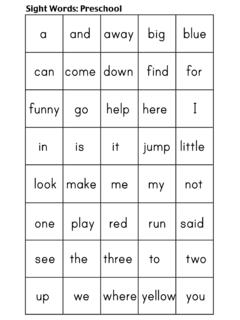Transcription of Aggression In Pembrokes - ISP.com
1 Aggression In Pembrokes by Liz Myhre ~myhre/. Unfortunately, the Pembroke Welsh Corgi breed has a world-wide reputation of biting that's been well-earned by certain members of the breed. Why is this? Is it due to their herding ancestry where for this smaller breed to herd cattle they had to push hard and nasty if the cattle pushed them? Maybe, maybe not. It should not be, as the herding instinct is a predatory drive instinct, while human/dog or dog/dog interactions are pack instincts. But I am not the one to say. But although Pembrokes generally make good family pets, enough individuals of the breed have problems that it is a breed problem. Many come from puppy mills or backyard breeders who don't screen out bad temperaments from their breeding stock, some come from show breeders who don't care, some come out of the blue from good temperamented bloodlines, but most problem biters are caused by owner mishandling.
2 Note that Cardigans have very different temperaments than Pembrokes , and have their own breed temperament problems. There's a range of degree of problems, from Pems that nothing could have prevented their aggressiveness (uncommon), to most that with proper upbringing and timely behavior training would not have problems but otherwise become biters, to dogs that would have no problems no matter how they were brought up (most Pembrokes ). Also, note that many dogs, even of good temperament, will quickly become defensive aggressive once attacked or badly scared by another dog. Corgis, being such fast learners, will often start attacking other dogs after being attacked themselves only once. Always keep your dog out of situations where he could potentially be attacked or scared. Off- lead dog parks or other areas where other uncontrolled dogs are loose are bad.
3 Always be aware of any situation where leashed dogs could reach yours due to their owner's inattention to their and your dog, ignorance of proper dog behavior. Be extremely careful at dog events especially in close quarters, passing others in parks, and in dog classes. Remember, it can only take one incident for your nice dog to become the nasty one! Dog/People Aggression Pems, in general, will try you. They will push you, they will give you the finger. And those most pushy ones, if you let them get away with such, can become aggressive. They will growl at you when you try to take food away, they will bite you if you pet them where they decide they don't want to be petted. They will snap when you try to move them off their favorite spot on your furniture. If you do not provide a firm leader (often the term alfa is used) status for the family, they will become the leader, and this is where trouble starts.
4 Our rescue groups receive too many of these dogs. Many, once given a firm hand by someone who knows the breed and behavior modification, are fine. Unfortunately most rescue groups are not allowed to accept any dogs with a biting history due to liability, so pet owners NEED to stop such behavior before it becomes the literal death of the dog. Biters are euthanized if given up. What's the answer? Try to find a puppy that is from a good temperamented background in the first place. Get references about a breeder from other pup buyers. Look at the dam and sire if on site to see how they react to strangers, men, and children (a child along even if you don't have one). Avoid pups that bully others in the litter or are easily scared. Don't buy from a pet store. Don't buy pups that are offered to go home before they learn proper littermate socialization, usually after 10wks old.
5 Note that puppy nipping is not necessarily Aggression , and should not be treated as such. You must determine the difference before trying to solve the problem. Puppy nipping is due to herding instinct (nipping at other's heels when running), lack of proper socialization as a pup (often due to being removed from parent and siblings before 7wks of age), and improper play or teasing the pup or dog by adults and especially children. Firmness, stubbornness, consistency in training, not allowing yourself to be pushed, or given the finger, not allowing the dog to get away with things. Be the leader of the family, and the dog will respect you. But what is necessary is NOT. being firm physically, as things like hitting or choking the dog with it's collar often leads to escalation of a war, but being firm with your mind.
6 Why did the dog give me the finger? How can I stop it from happening again? How can I stop it today? EXTREMELY IMPORTANT, Nipping Problems In The Bud. Eliminating a problem after the several incidences is way WAY harder than eliminating a behavior after a dog's only done it once. The dog is much more likely to offend later even with strict training, leading to a continual battle of trying to stopper up the behavior. And, you get driven into a deadly circle once a dog threatens you. The dog threatens, you become afraid of bites (quite rightly) and back off from the dog, the dog says hey I'm more alfa and pushes you more. So, best to Nip In The Bud before you get to this stage. Good behavior modification training exercises for owners. These simple exercises are non-confrontational so will not start a war, and do a good job at decreasing a dog's ranking over you.
7 These are good to use with pups/dogs that show signs of wanting to control you, and many are good to use after problems occur. Many are good to do with pups no matter what, avoiding the start of any problems in the first place (indicated with a *). 1. Never use confrontational methods like rolling a dog on it's back, holding it's throat, or hitting in a dog that has shown signs of Aggression problems to people. This can lead to increased problems such as serious biting or full scale attacking. The idea is to gradually lessen the dog's ranking and increasing yours, without battles. Or, preferable, never let the dog get ahead of you in the 1st place. 2. *Never allow a dog to avoid something (nail clipping, punishment, doing something they're told to do, coming) by hiding under the deck or bed where you can't reach them, or running away from you in a big yard when you want to reprimand them or get them to do something (ie they're giving you the finger).
8 Instead block off the hiding area, leave a long lead on them when in the yard that you can latch onto and reel in when they run. Or simply stalk them down until you catch them. This is a common problem in many teenage dogs of all breeds, but put a halt to this in Pems. 3. *Dogs should understand that you are the leader who provides them their creature comforts such as food, water, playtime. Dogs with problems should not be free-fed, they should be given meals that they finish in 10 minutes or it will be removed. All dogs should learn to sit stay for a short while before being allowed to eat. This reinforces your rank as boss. If you need to if the dog isn't good at that initial stay or protects his food after 10 minutes, use a leash to restrain or remove the dog from the food. 4.
9 *Train the dog to allow you to take things like his dinner, chewies, and toys away from them without possessiveness in the first place. Reinforce this training thruout the dog's life. Before you have any problems, even if the dog promises to never be a problem dog, teach the dog that you taking things away from him is good. Take an item (food, toy, chewie, etc) away, quickly give them a treat reward if they don't object, then quickly give the item back. The treat must be more attractive to them than the toy or chewie, so get a better treat if they prefer to hang onto the toy/chewie. Repeat later, keeping the item longer each time. 5. If a dog has just started showing signs of possession about something, don't let them have it unless they're good. Take it away and let them know that This is MINE thank you, and I only give it to you by my grace.
10 Stare them down, speak firmly No, Mine. And allow them to have it again if they're good again, but remind them often that that is yours to give them, not theirs to take. I once put Ty on a brand new floor cushion as a pup. Then I sat on it and he immediately got PO'ed and tried to push me off. He had decided that he was in control, not me. So, I sat there, letting him learn that that was MY cushion thank you, not his. And I thereafter sat in his doggie bed too, to show him that it was mine first, his if I allowed it. When Jordan first came to me as a pup, he was food possessive with other dogs, curled around his dinner dish and growled at my others. I took the dinner away from him when he did this (he wasn't people food possessive or there would have been the danger of him bitting me, not recommended!)








